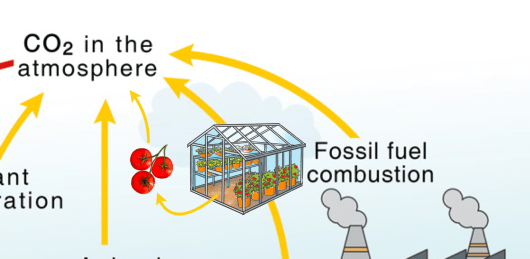This year, Luuk Graamans and I published a report on CO2 enrichment for Dutch greenhouse horticulture. It is in English and can be read here. I’m not writing this article to summarise our report – but examining CO2 reminded me of some common misconceptions about circularity.
These misconceptions are more common than I had expected, and lead to unhelpful greenwashing. They apply to all material flows, but CO2 is a good example.
To understand how CO2 – and carbon generally – should be managed sustainably, it is important to understand the carbon cycle. If you are already familiar with it, you can skip this next section.
The Carbon Cycle(s)

In nature, atmospheric CO2 gets taken up by primary producers (e.g. plants), where it is turned into biomass. This biomass is eaten by heterotrophs (e.g. animals or fungi), who use it for energy and growth. Most of this carbon gets respired as CO2. When organisms die, they decompose, releasing the rest of the carbon. This gets taken up by the primary producers and the cycle starts anew.
This is not the only way carbon moves through natural ecosystems, but it is the most common and quickest. It is referred to as the ‘fast’ (or ‘short’) carbon cycle.
So what’s the ‘slow’ (a.k.a. ‘long’) carbon cycle, then? The slow carbon cycle involves carbon slowly being deposited in sinks, built up over years, if not centuries. Carbon sinks include petroleum reservoirs and peat bogs, but also soil and forests.
Not all CO2 is the same
Surely CO2 emissions are CO2 emissions?
The problem does not lie with the emission of CO2 as such. When looking at a process’s carbon footprint, only CO2 emitted from the slow cycle counts. Burning biobased fuels, or humans breathing out CO2, doesn’t, because this carbon came from the air not too long ago anyway. It’s a bit like spending money from your current account versus digging into your savings.
The two categories of carbon cycle aren’t entirely clear-cut. Petroleum reservoirs form very slowly, whereas forests can be grown quickly. Planting a forest and burning its wood 5 years later would count as part of the fast carbon cycle – but burning down an ancient rainforest, where the carbon was stored and out of circulation for millennia, would count as CO2 emissions from the slow carbon cycle.
The way to look at it is to look at what we want to avoid. We want to avoid a net increase in the CO2 concentration in the atmosphere. Doing this through burning fossil fuels means that (1) carbon sinks are being used up faster than they are re-generated and (2) CO2 is being generated faster than it can be reabsorbed. The carbon cycle is out of balance.
Circular Economy Greenwashing
When looking at a supposedly ‘circular’ solution to dealing with a material flow, always ask:
- Where did it come from?
- Where does it end up?
Using the by-products of one process as inputs for another is a necessary strategy for circularity – but that in itself is not sufficient to having a circular economy as a whole. It’s easy to mistake using these strategies on their own for full sustainability. For example, wood is a biofuel, but burning wood from an ancient rainforest faster than it can grow back is not sustainable.
Examples in Greenhouse Horticulture
Where does the CO2 used to enrich greenhouses come from? Fossil fuels. Yes, this is CO2 that would have been generated anyway – either for heating or generating electricity – but it is still fossil, and it will run out at the rate it’s being consumed.
Where does it end up? Well, at least 80% goes straight to the atmosphere… but even for the remaining 20% that is taken up in the crop, it eventually is either eaten or decomposed. In other words, it gets released into the atmosphere. Pumping CO2 into greenhouses is often likened to carbon sequestration, but that would only be the case if we started burying tomatoes en masse.

Even 100% uptake efficiency would not change this – only the rate at which it would be happening. The only CO2 that should be used for greenhouses should either come from new biomass, or directly from the air through carbon capture.
The same even applies to aquaponics. Aquaponics is a great way to reduce pollution from aquaculture, whilst reducing the need for fertilisers. But even there, we can ask the same questions. For example, does the fish feed come from unsustainably-caught fishmeal, or perhaps from soybeans grown using finite mineral fertilisers?

My favourite example are houses built with used plastic bottles. Like aquaponics, this idea reduces the need for building materials. But what is the endgame here? A planet full of plastic houses, where we still need to dig up oil to produce new plastic bottles anyway?

Conclusion
This article isn’t meant to bash CO2 enrichment, aquaponics, or houses made of plastic bottles. After all, they all make use of a by-product that is available anyway, and reduce natural reserve depletion – which is an increase in sustainability. But it is not enough to focus on the use of a waste stream from one process as an input for another. For every flow, we need to look at its origins, its destination, and the effect of both on the balance of the entire cycle.
